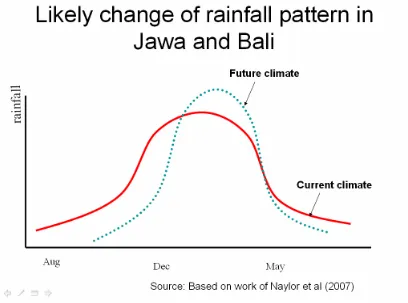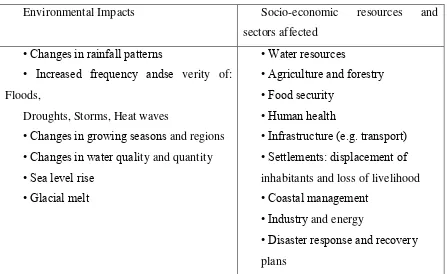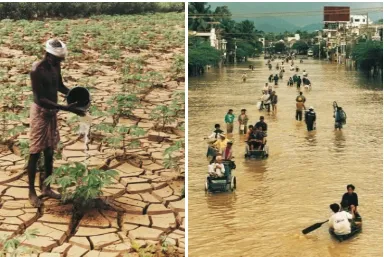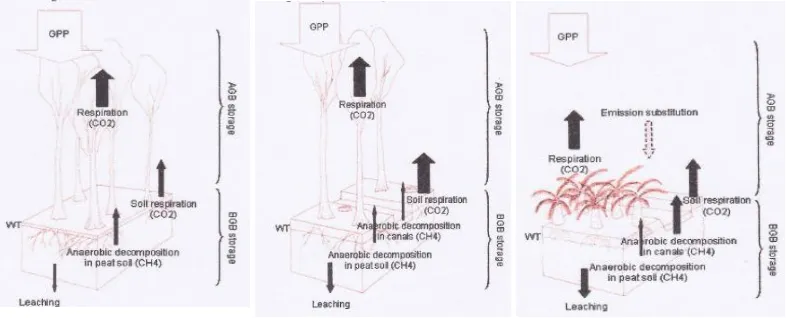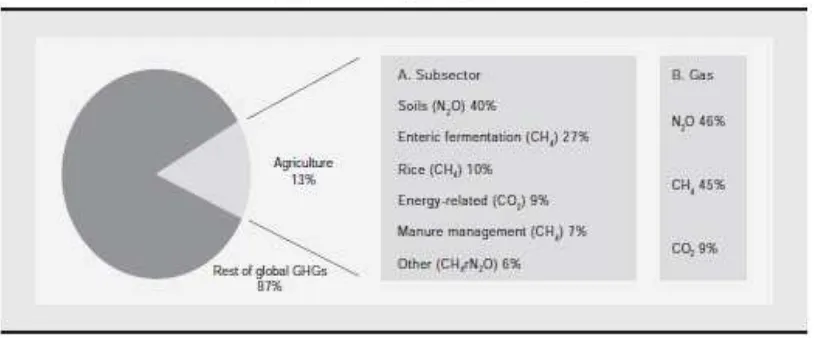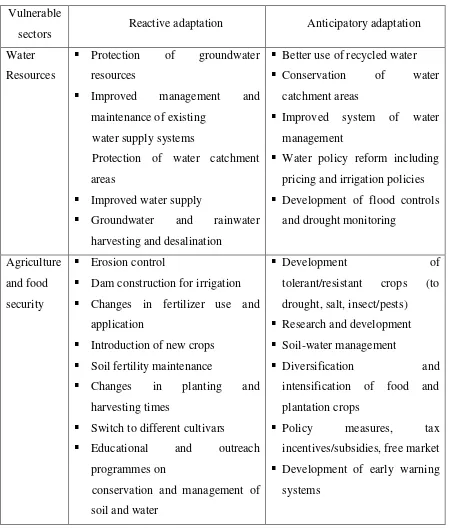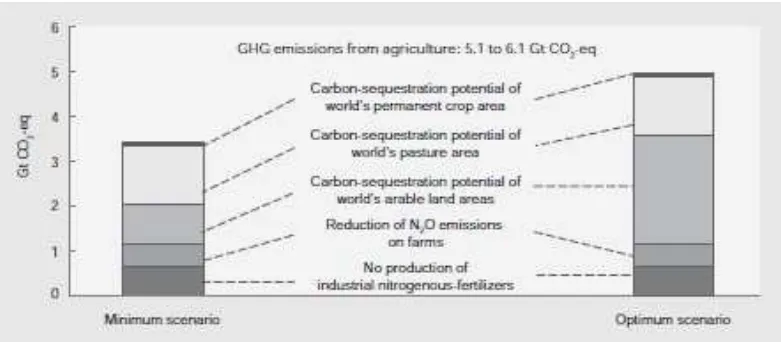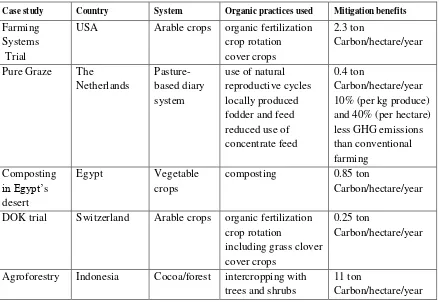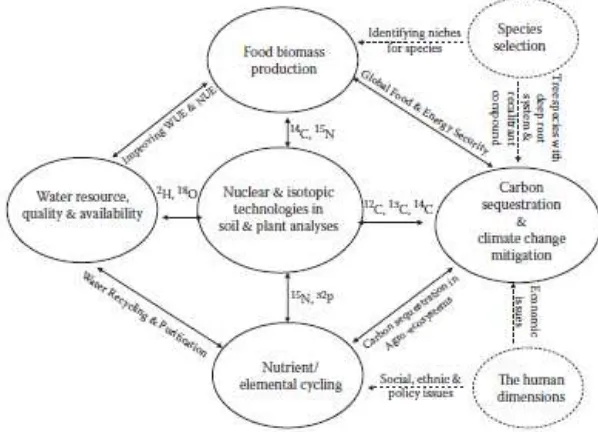101
Significance of Nuclear-Isotopic Technologies in food security,
adaptation and mitigation of climate changes
Setiyo Hadi Waluyo
Center for The Application of Isotopes and Radiation, National Nuclear Energy Agency.
ABSTRACT
The most negative effect of global warming is climate change that leads to water scarcity. Rising global temperature intensifies hydrological cycle resulting heightened risks of more extreme erratic rainfalls and frequent drought and floods. On the other hand, unsustainable uses of natural resources increase worldwide degradation of extensive tracts of lands. Therefore, the impacts of global warming are the increasing risks of life and health, especially for people in developing countries. It is predicted that billion of people, particularly in the developing countries would faces shortages of water and foods in the next decades, as a result of the increasing pressure of lands and water resources to produce sustainable food security. Thus global action is needed to enable the developing countries to adapt and mitigate those climate changes. Agriculture has significance roles in food security and climate changes, since agriculture is one of an important source of greenhouse gas emissions. Whilst the developing countries contribute most of those emissions. On the other hand, most of the technical mitigation of agriculture could be realized in developing countries. Thus agricultural systems could contribute significantly to overall mitigation, that hopefully could reduce the extent of required adaptation and catastrophic in developing countries. Agricultural system would need to adapt unavordable climate changes and its impacts, in order to ensure the food security. Improving agricultural water management is one of the important ways for adapting agricultural production to combat the global warming and climate changes. Nuclear-Isotopic Technologies have been developed well and used intensively for ecological and agricultural purposes. This paper would review the potential role of Nuclear-Isotopic technologies in exploring potential synergism between food security, adaptation, and mitigation to produce an agricultural system that is more resilient to climate variability.
102
INTRODUCTION
The world population is expected to be 8 billion by the year 2020, in which most of
the population increases will occur in developing countries where the majority depend
upon agriculture for their livelihoods. Therefore a pressure on the availability of land and
water resources is facing by the developing countries to achieve a sustainable food
security.
Besides this pressing issue, the increasing risks and impacts of the global warming
and climatic variability need to be considered as well. Global warming is convinced to
have negative impacts and induce climate changes. In turn it will put increasing pressures
on sustainable land and water resources to produce sufficient food for the ever-increasing
world population.
Climate change is an important global issue to be tackled. Climate change is
alteration of the composition of the global atmosphere and natural climate variability
observed over comparable time periods. It is caused by increasing greenhouse gasses
(GHGs) of the earth’s atmosphere (Table 1). These gasses allow solar radiation from the sun to travel through the atmosphere but prevent the reflected heat from escaping back
into space. This causes the earth’s temperature to rise, polar meltdown, sea level rise, desert climate change, flora and fauna extinction, emergence of new diseases, etc. The
effects of climate change so far have appeared in the form of extreme weather, including
heavy rainfall in shorter periods of time further leading to floods and landslides, and an
increase in frequency and intensity of drought in parts of Asia and Africa in recent
103 Table 1. Global Warming Potential (GWP) of Main Greenhouse Gases (GWP-GHGs)
Species Antrophogenic
they have fewer resources to adapt socially, technologically and financially. Climate
change is anticipated to have far reaching effects on the sustainable development of
developing countries including their ability to attain the United Nations Millennium
Development Goals by 2015 (UN 2007). Many developing countries’ governments have
given adaptation action a high, even urgent, priority. However, developing countries have
very different individual circumstances and the specific impacts of climate change on a
country depend on the climate it experiences as well as its geographical, social, cultural,
economic and political situations. As a result, countries require a diversity of adaptation
measures very much depending on individual circumstances. However there are cross
cutting issues which apply across countries and regions (Table 2).
Climate change solutions need to be identified and exploited synergy, as. well as
seek to balance trade-offs, among the multiple objectives of sustainable development,
disaster risk reduction and adaptation policies. Such initiatives also require new and
sustained funding sources. The same sectors that are affected by climate change, albeit to
differing degrees, are agriculture, water resources, human health, terrestrial ecosystems
104
still in its infancy, the Parties of the UNFCCC are increasing their support for action on
adaptation. This includes the development of national adaptation programmes by some
developing countries including least developed countries, and their integration into
national strategies.
Over the next decades, it is predicted that billions of people, particularly those in
developing countries, face shortages of water and food and greater risks to health and life
as a result of climate change. Therefore, concerted global action is needed to enable
developing countries to adapt to the negative effects of climate change that are happening
now and will worsen in the future.
In Indonesia, the effects of climate change include the increase of temperature by an
average of 0.3 °C since 1990, two to three percent increase in precipitation, harvest
failures are threatening food security in some areas . Sea level rise causing the
submergence of coastal fish and food cultivation areas as well as disappearance of small
islands, and ocean temperature increase causing coral bleaching . West Sumatra, South
Sumatra, Western Java, and Eastern Java of Indonesia are among the most vulnerable
regions to climate change in Southeast Asia (Figure 1).
105 As one of the most vulnerable regions in Southeast Asia, there are two reasons why
Indonesia needs to be proactive in combating climate change. First, as the third largest of
CO2 emmiter and characteristics of the geographical, geophysical and biological,
Indonesia has the opportunity to play an important role in the global effort to stabilize
climate. Second, the initial step of the important role has already begun, as Indonesia
became the host of the 13th Conference of the parties of the UNFCCC, resulting in the
Bali Road Map. Indonesia was also involved in the formulation of an initiative called the
reduction of Emissions from Deforestation and Degradation (REDD). With the
commitment to reduce GHG emission by 26 percent (or 41 percent with the assistance of
developed countries), Indonesia also shows its important contribution to the global effort
towards addressing the impacts of climate change. This will lead to various political and
economic efforts to create opportunities for the Indonesian stakeholders to participate in
the reduction of carbon emissions from various sectors and the improvement of
environmental quality.
The impact and consequences of global warming for agriculture in
developing countries
The food price crisis of 2008 has led to the re-emergence of debates about global
food security and its impact on prospects for achieving the first Millennium Development
Goal (MDG) to end poverty and hunger. Meanwhile, global climate change is considered
as posing the greatest threat to agriculture and food security in the 21st century,
particularly in many of the poor, agriculture-based countries such as South East Asia and
Africa with their low capacity to effectively cope.
The impacts of climate change are already being experienced across the globe. The
main impact of global warming on agricultural production can be summarized as follows:
• Higher temperatures affect plant, animal and farmers’ health, enhance pests and reduce
water supply increasing the risk of growing aridity and land degradation. • Modified
precipitation patterns will enhance water scarcity and associated drought stress for crops
and alter irrigation water supplies. They also reduce the predictability for farmers’
planning. • The enhanced frequency of weather extremes may significantly influence both
infra-106
structure for agriculture. • Enhanced atmospheric concentrations of CO2 may, for a
limited period of time, lead to ‘natural’ carbon fertilization and thus a stimulus to crop
productivity. • Sea level rise is likely to influence trade infra-structure for agriculture, may inundate producing areas and alter aquaculture production conditions.
Generally, the impact and consequences of global warming for agriculture tend to be
more severe for countries with higher initial temperatures, greater climate change
exposure, and lower levels of development. Particularly hard hit will be areas with
marginal or already degraded lands and the poorest part of the rural population with little
adaptation capacity.
This impact of global warming has significant consequences for agricultural
production and trade of 2080 suggest a decline of some 15–30 per cent of agricultural productivity in the most climate-change-exposed developing country regions – Africa and South Asia. For some countries in these regions, total agricultural production could
decline by up to 50 per cent. The poorest farmers with little safeguards against climate
calamities often live in areas prone to natural disasters. More frequent extreme events will
create both a humanitarian and a food crisis (Table 2).
Table 2 Climate change impacts in developing countries.
Environmental Impacts Socio-economic resources and
sectors affected
• Changes in rainfall patterns
• Increased frequency andse verity of: Floods,
Droughts, Storms, Heat waves
• Changes in growing seasons and regions
• Changes in water quality and quantity
107
Water scarcity
The four major factors driving the increasing water demand are population growth,
industrial development, the expansion of irrigated agriculture, and the impacts of climate
change and climate variability. Water is a major input for agricultural production under
both rainfed and irrigated conditions. Agriculture is the predominant user (75%–80%) of the available freshwater resources in many parts of the world. About one-third of the
world’s population lives in countries suffering from moderate to high water stress. By 2020, water use is expected to increase by 40% and 17% more water will be required to
produce the food requirements of the growing population . Competition among different
sectors for scarce water resources and increasing public concern about water quality for
human, animal, and industrial consumption and recreational activities, have focused more
attention on water management in agriculture. As water resources shrink and competition
from other sectors grows, agriculture faces a dual challenge: to produce more food with
less water and to prevent the deterioration of water quality through contamination with
runoff, soil erosion, and sedimentation, and associated nutrients and agrochemicals .
The most negative impacts of climate change will be water scarcity. Changing
climate will have significant impacts on the availability of water, as well as the quality
and quantity of water that is available and accessible. Rising global temperatures will lead
to an intensification of the hydrological cycle, resulting in dryer dry seasons and wetter
rainy seasons, and subsequently heightened risks of more extreme and frequent floods and
drought (Figure 2). Increased evaporation and evapotranspiration with associated
soil-moisture deficits will impact rainfed agriculture. Recent estimates show that for each 1°C
rise in average temperature dryland farm profits in Africa will drop by nearly 10% (FAO,
2008b). In addition, increased evaporation of open water storage can be expected to
108
Figure 2 . Extreme results of climate change (drought and floods)
The outlook for the coming decades is that agricultural productivity needs to
continue to increase and will require more water to meet the demands of growing
populations. Ensuring equitable access to water and its benefits now and for future
generations is a major challenge as scarcity and competition increase.
Land and soil-quality degradation
In a recent situation analysis of the food and agricultural sector in the developing
world, it was noted that among several issues of global significance, the status of land
degradation has continue to worsen in many parts of the world, and the impacts of climate
change have exacerbating pressures on the natural resources. This increased worldwide
degradation of extensive tracts of land causes a decline in productivity, disrupts vital
ecosystem functions, negatively impacts biodiversity, and increases vulnerability to
climate.
Both land-use change and intensification of agricultural production on existing
109 can reduce soil organic matter and increase soil erosion by removing permanent soil
cover. The removal of plant residues can reduce soil nutrient contents and increase
greenhouse gas emissions through losses of soil carbon. The most significant indirect
emissions are changes in natural vegetation and traditional land use, including
deforestation and soil degradation. Soil carbon losses caused by agriculture account for
one tenth of total CO2 emissions attributable to human activity since 1850. Deforestation
is a common land-preparation practice in many agricultural regions that leads to massive
loss of carbon stocks and massive CO2 emissions. The IFOAM Basic Standards for
Organic Production and Processing prohibit the clearing of primary eco-systems. The
world’s soil is however a major store of carbon – approximately three times the amount in the air and five times as much in forests (Figure 3).
Figure 3. Carbon fluxes caused by natural land and ecosystem conversion (left to right :
primary/undrained; drained and partly logged; oil palm plantation)
Improper management agricultural practice pronounce the impact on environment.
Clearing of all vegetation and construction of roads will reduces the permeability of the
land, causes a loss of soil faunal activity, and compacts the land, all of which increases
top soil runoff and causes soil erosion. Therefore cultivation of monoculture at large scale
on such condition has a negative effect on soil fertility. Top soil prone to erosion and as
impacts degradation of soil fertility takes place. Continued land degradation has major
impacts on future agricultural supply response. Salinization of soils, nutrient depletion
and soil erosion all reduce the productivity of lands for agricultural production. In cases
110
UNEP estimates a loss of 0.2 percent in cropland productivity per year globally due to
unsustainable agricultural practices.
Food security
Food security is defined as a ‘situation when all people, at all times, have physical, social and economic access to sufficient, safe, and nutritious food that meets their dietary
needs and food preferences for an active and healthy life’. All dimensions of food security are likely to be affected by climate change . Importantly, food security will
depend not only on climate and socio-economic impacts on food production, but also (and
critically so) on economic growth, changes to trade flows, stocks, and food aid policy.
Threats from climate change, population growth and unsustainable resource use are
affecting different regions of the world. Trends in population, diet, resource degradation
and climate change impacts on productivity indicate that there is a real risk of global food
shortfalls as the century progresses. It is obvious that food insecurity and climate change
are already inhibiting human well-being and economic growth throughout the world.
These problems are poised to accelerate. However, countries vary in their vulnerability to
climate change, the amount and type of GHGs they emit and their opportunities to reduce
GHG emissions and improve agricultural productivity.
Under present trends, by 2030, maize production in Southern Africa could decrease
by up to 30% while rice, millet and maize in South Asia could decrease by up to 10%. By
2080, yields in developing countries could decrease by 10% to 25% on average while
India could see a drop of 30% to 40%. By 2100, while the population of three billion is
expected to double, rice and maize yields in the tropics are expected to decrease by 20– 40% because of higher temperatures without accounting for the decrease in yields as a
result of soil moisture and water supplies stressed by rising temperatures. Future
warming of around 3 °C (by 2100, relative to 1990–2000) could result in increased crop yields in mid- and high-latitude areas, but in low-latitude areas, yields could decline,
increasing the risk of malnutrition. A similar regional pattern of net benefits and costs
could occur for economic (market-sector) effects. Warming above 3 °C could result in
crop yields falling in temperate regions, leading to a reduction in global food production.
To feed 9 billion world population by 2050, the world will need to produce
approximately 70% more food than at present to cope with growing population and
111 under ever increasing pressure. It is important to gain a better understanding of the
functioning of terrestrial and aquatic ecosystems and their interrelation with the
availability and quality of water. This calls for a shift in the management of ecosystems
and the water within them for food security. Agricultural production systems have to be
recognized and managed as a landscape of interlinked agro ecosystems with the potential
for multiple functions (Figure 4). Building resilience to climate change and other shocks
needs to be mainstreamed into agricultural planning to ensure food security targets.
Figure 4. Landscape and hydrological cycle of agro-forestry system
Sustainable agriculture
Agriculture is at the nexus of three of the greatest challenges of the 21st century – achieving food security, adapting to climate change, and mitigating climate change while
critical resources such as water, energy and land become increasingly scarce.
Sustainable agriculture simultaneously increases production and income, adapts to
climate change and reduces GHG emissions, while balancing crop, livestock, fisheries
and agroforestry systems, increasing resource use efficiency (including land and water),
protecting the environment and maintaining ecosystem services. The goal for sustainable
food production systems is to maximize productivity of both land and seascapes within
humanity’s ‘safe operating space’ for the planet–‘safe’ from the perspective of achieving food security within the planet’s safe environmental boundaries. Contexts will vary in different geographic regions and locations. Improvements to agricultural production
systems should allow more productive and resilient livelihoods and ecosystems,
112
adequate food and nutrition, and allowing poor rural people to escape from and remain
out of poverty. Sustainable agriculture lies at the heart of delivering poverty reduction.
Mitigation and adaptation
Agriculture plays four important roles in climate change: • Farming emits
greenhouse gases (GHGs). • Changes in agricultural practices have a big potential to be carbon sinks. • Changes in land use, caused by farming have great impact on GHG emissions. • Agriculture can produce energy and bio-derived chemicals and plastics, which can replace fossil fuel. Therefore, agricultural sector can be an important part of
the solution to climate change. This can be done by capturing synergies that exist among
activities to develop more productive food systems and improve natural resource
management. Increased agricultural productivity and resilience, under changing the
climatic conditions, can benefit to poverty reduction, especially among vulnerable
smallholder farmers. Consequently, agriculture practice can be put for an early action
since it is readily available and cost-effective mitigation option. Technically mitigation
potent of agriculture is high, of which 70 percent can be obtained from developing
countries. This sector contributes 14 percent of global GHGs, of which 74 percent comes
from developing countries (Figure 5). Therefore global climate change concerns has put
the agriculture sector, particularly in developing countries in more broad responsible, i.e.
to be resilient (adaptation) to climate changes, to reduces/removes greenhouse gases
(GHGs, mitigation), and to enhance achievement of food security and millenium
development goals (MDGs).
113 The scale of action needed to tackle climate change is unprecedented and involves
two concurrent approaches: • Mitigation: actions that tackle the causesof climate change,
such as reducing greenhouse gas emissions.• Adaptation: actions that minimise the consequences of actual and expected changes in the climate. These processes are
inherently linked. Adaptation should enable agricultural systems to be more resilient to
the consequences of climate change. Mitigation addresses its root causes, thereby limiting
over time the extent and cost of adaptation, as well as the onset of catastrophic changes.
Both are needed and a number of agricultural management practices can do both, while
helping to meet development and food security requirements. They are likely to receive
increasing priority within holistic approaches to food security and climate changes.
Increased agricultural resilience and productivity, under changing climatic conditions, can
benefit poverty reduction, especially among vulnerable smallholder farmers. A wide
range of options in agriculture offer such potential synergies. Others may involve
trade-offs, some of which can be managed. The degree to which society needs to adapt depends
on the extent of climate change, which depends on greenhouse gas emissions. The Kyoto
Protocol (1997) to the United Nations Framework Commission on Climate Change
(UNFCCC) requires ratifying industrialised countries to limit their greenhouse gas
emissions by agreed amounts below their 1990 levels over the period 2008-2012. Under
REDD scheme developing countries having huge tropical forest could play important role
on climate change by reduction of GHGs emissions.
Adaptation
Agriculture, in a number of areas, already needs to adapt to more rapid and intense
changes in climate (temperature, rainfall) and related changes in distribution patterns of
pests, weeds and diseases. Because of the climate change speed pressure, it is urgent that
the vulnerability of developing countries to climate change is reduced and their capacity
to adapt is increased and national adaptation plans are implemented. Future vulnerability
depends not only on climate change but also on the type of development path that is
pursued.Thus adaptation should be implemented in the context of national and global
sustainable development efforts. The international community is identifying resources,
tools and approaches to support this effort. Climate change adaptation is especially
important in developing countries since those countries are predicted to bear the brunt of
114
Adaptation to climate change in developing countries is vital and has been
highlighted by them as having a high or urgent priority. Although uncertainty remains
about the extent of climate change impacts, in many developing countries there is
sufficient information and knowledge available on strategies and plans to implement
adaptation activities now. The mosteffective adaptation approaches for developing
countries are those addressing a range of environmental stresses and factors. Strategies
and programmes that are more likely to succeed need to link with coordinated efforts
aimed at poverty alleviation, enhancing food security and water availability, combating
land degradation and reducing loss of biological diversity and ecosystem services, as well
as improving adaptive capacity. Sustainable development and the Millennium
Development Goals are a necessary background to integrating adaptation into
development policy. Reduction policies are also important elements of adaptation.
The challenges of adaptation to climate change for agriculture in many parts of the
world are enormous. The process of adaptation begins with an assessment of the different
dimensions of vulnerability and of the appropriateness of a range of potential options for
action, including their costs and benefits. In practice, adaptation is a collection of coping
strategies, with each strategy focused on a particular threat. Some of these actions may be
taken by individuals or communities reacting to climate change hazards as they occur;
others may be more planned, depending for their initiation on government policies and
115 Table 3. Adaptation measures in key vulnerable sectors highlighted in national
communications of developing countries
Vulnerable
sectors Reactive adaptation Anticipatory adaptation
Water
Resources
Protection of groundwater
resources
Improved management and
maintenance of existing
water supply systems
Protection of water catchment
areas
Improved water supply
Groundwater and rainwater
harvesting and desalination
Better use of recycled water Conservation of water
Educational and outreach
programmes on
conservation and management of
soil and water
intensification of food and
plantation crops
Another policy response to climate change, known as climate change mitigation is
to reduce greenhouse gas (GHG) emissions and/or enhance the removal of these gases
116
their sinks. Even the most effective reductions in emissions, however, would not prevent
further climate change impacts, making the need for adaptation unavoidable. In the
absence of mitigation efforts, the effects of climate change would reach such a magnitude
as to make adaptation impossible for some natural ecosystems. For human systems, the
economic and social costs of unmitigated climate change would be very high.
Many countries, both developing and developed, are aiming to use cleaner, less
polluting, technologies. Use of these technologies aids mitigation and could result in
substantial reductions in CO2 emissions. Policies include targets for emissions reductions,
increased use of renewable energy, and increased energy efficiency. Studies indicate
substantial potential for future reductions in emissions. Despite the many examples of
successful attempts to reduce GHG emissions in agriculture within different
environments, overall the potential for implementing large-scale mitigation measures has
seen relatively little progress. Barriers include limited access to finance, technology and
resources and lack of appropriate political, institutional and economic policies, as well as
the possibility of short-term yield losses followed by long-term gains with some types of
mitigation practices.
Scientific consensus on global warming, together with the precautionary principle
and the fear of abrupt climate change is leading to increased effort to develop new
technologies and sciences and carefully manage others in an attempt to mitigate global
warming. Most means of mitigation appear effective only for preventing further warming,
not at reversing existing warming. The Stern Review identifies several ways of mitigating
climate change. These include reducing demand for emissions-intensive goods and
services, increasing efficiency gains, increasing use and development of low-carbon
technologies, and reducing fossil fuel emissions.
117 Agriculture is currently the most cost-effective, market-ready way to remove carbon
dioxide from the atmosphere. Scientific research is needed to determine which
agricultural techniques, practices, and systems will achieve actual climate mitigation.
With the right type of agriculture, emissions leading to climate change can be minimized
and the capacity of nature to mitigate climate change can be harnessed to sequestrate
significant quantities of atmospheric carbon dioxide – especially in the soil (Figure 6). The Farming Systems Trial offers an opportunity to examine the climate mitigation
potentials of different existing agricultural systems. The results suggest the huge
possibilities for agriculture. Global adoption of Organic Agriculture has the potential to
sequester up to the equivalent of 32% of all current man-made GHG emissions. Organic
Agriculture is a production system that sustains the health of soils, ecosystems, high crop
yields, and people. It utilises ecological processes, biodiversity and cycles adapted to
local conditions, rather than the use of inputs with adverse effects. It combines tradition,
innovation and science to benefit the shared environment and promote fair relationships
and a good quality of life for all involved. The Food and Agriculture Organisation of the
United Nations (FAO) regards Organic Agricultural as an effective strategy for mitigating
climate change and building robust soils that are better adapted to extreme weather
conditions associated with climate change5. The IPCC’s Fourth Assessment Report also
recommends the use of practices which are standard in Organic Agriculture for mitigating
climate change. Organic Agriculture optimally combines these different practices in a
systematic manner and sustains agricultural production in resource-limited regions.
Organic farming system can sequester significant levels of carbon dioxide from the
atmosphere ranged from 0.25 up to 11 ton per ha per year (Table 5).
118
Table 5: Overview of key the case studies
Case study Country System Organic practices used Mitigation benefits
Farming Systems Trial
USA Arable crops organic fertilization
crop rotation
DOK trial Switzerland Arable crops organic fertilization
crop rotation
including grass clover cover crops
0.25 ton
Carbon/hectare/year
Agroforestry Indonesia Cocoa/forest intercropping with
trees and shrubs
11 ton
Carbon/hectare/year
The Role of Nuclear-Isotopic Technology in food security and global warming
Nuclear-isotopic techniques (NITs) offer unique contributions to promote more
sustainable and resilient agricultural production, at the same time being safe and cost
effective. For example, they can be used to compare and measure the efficiency and
efficacy of different agricultural land and water resource management practices.
Identifying and refining the best of these practices is crucial to the long term preservation
of natural resources such as arable soils and water, which are under increasing pressure
due to climate change.
Water is perhaps the most precious of natural resources, and the resource most
threatened by climate change. Already under significant stress worldwide due to
expanding populations and economic activity, freshwater resources in many regions are
suffering a double blow due to climate change. This is placing many communities at risk
and demands greater efforts to promote sustainable resource management and increase
water availability. Isotope techniques provide highly effective, cost efficient and safe
119 flow origins and replenishment rate. This knowledge is necessary to help water authorities
manage their resources in a more sustainable manner. It is of even greater importance
with regard to aquifers, as communities are increasingly forced to turn to these
underground resources due to the diminishing availability of surface water.
There is a wide range of isotopic (stable and radioactive) and nuclear techniques
that can be potentially used to study specific issues related to soil quality and health, plant
nutrition, crop physiology, and crop water productivity and water use efficiency. The soil
moisture neutron probe (SMNP) has been widely utilized in agricultural research studies
on water use efficiency. Soil water content at different depths in the soil profile can be
measured periodically. This SMNP provides a rapid, reliable, cost-effective, and
nondestructive technique and is still considered as the reference equipment for field
monitoring of soil water content. Data generated from this monitoring are used for
calculating the soil water balance and estimating the soil water used by plants in function
of soil depth and time. Thus, the SMNP provides an evaluation of evapotranspiration
(ET), i.e., the bulk amount of soil water loss associated with soil evaporation and
transpiration out of plant leaves. The SMNP is also used in studies to evaluate WUE
under different irrigation technologies like drip irrigation, subsurface drip irrigation,
deficit irrigation, regulated deficit irrigation, alternate root-zone drying, and alternate
furrow irrigation, that aim to minimize soil evaporation and increasing water availability
for plant use. It can be employed to assess the quantity of water supplied by surface
120
Figure 7. Isotopic composition of C, O and H pools in Terrestrial ecosystems. The values
are approximations and will vary considerably with geographical location and
environmental Conditions.
Stable isotopes of water, 2H, and 18O at the natural abundance level have been
extensively used in plant-water relations research to investigate physiological and
hydrological processes from plant to ecosystem scale (Figure 4, Figure 7). Thus, stable
isotopes of water are routinely measured for tracking sources of water in vegetation. In
agriculture, the crop water requirements are evaluated as bulk evapotranspiration, which
includes both soil evaporation and plant transpiration. Due to the natural fractionation
among isotopes of hydrogen and oxygen, soil water at increasing depths in the soil profile
and plant materials have their own fingerprint. Therefore, it is possible to partition
evapotranspiration into its two components in order to obtain information to minimize
soil evaporation, the nonproductive loss of water. Both hydrogen (H) and oxygen (O),
which are element constituents of water can exist as light and heavy isotopes. The light
isotopes (1H and 16O) evaporate more readily than the heavy isotopes (2H and 18O).
121 as the enrichment of 2H (δ 2H) and 18O (δ 18O) in soil water. Water vapor within the plant canopy and plant leaves can provide an estimate of soil evaporation (E) and plant
transpiration (T).
Carbon isotope discrimination (CID) may be used as a tool for assessing crop Water
use efficiency (WUE). WUE is often considered as the mass of carbon dioxide fixed by
the plant in exchange for the mass of water transpired. During photosynthesis, carbon
dioxide is subjected to an isotopic fractionation, with lighter 12C more readily taken up
by plants than 13C. The kinetics of diffusion of carbon dioxide and water through the leaf
stomata openings depends on the size of their aperture. Under drought stress, the plant
closes its stomata, a process which impedes both exchanges. A side effect is the
discrimination of the heavy isotopes of C, O and H; therefore, water scarcity results in a
plantdepleted content in 13C, for example, which is measured by the ratio of 13C/12C
(i.e., δ13C) in its dry matter. A cultivar that is resistant to water scarcity should display less depletion in 13C compared to a susceptible cultivar). Soil scientists as well as plant
breeders have used this method strategically for screening and evaluating WUE of crops
such as barley, bread wheat , peanut, and upland rice. For rice (Oryza sativa L.), the CID
values from flag leaves can potentially be used to select rice for salinity tolerance, since
flag leaf CID correlated well with grain CID, and both positively correlated with grain
yield. In addition, CID measured in different plant parts at harvest can be used as an
indicator of how water availability varied during the cropping season.
In addition, the isotope technology plays an important function in the management
and assessment of hydrology and water resources, especially on ascertaining the recharge
sources, amounts and ages of groundwater, the interaction between surface water and
groundwater, the effects on the pollution of surface water to groundwater, etc. We can
obtain many key data with little investment, which can’t be obtained by other regular methods. Meanwhile, environmental radionuclides of 7Be, 137Cs, and 210Pb have been
used to obtain information on short-term (< 30 days), medium-term (~40 years) and
long-term (~100 years) average soil redistribution rates and patterns in the landscape,
respectively, and hence area-wide (watershed) erosion and sedimentation.
The development of an integrated nutrient management package (involving not only
manufactured fertilizers but also natural sources of nutrients such as rock phosphates,
122
residues has resulted in a greater demand for the use of 15N, 32P, and sulfur-35 (35S)
isotopes as tracers to develop efficient agronomic practices tailored to the specific
cropping systems and local conditions. Significant advances have also been made during
the past decade in the development and application of natural variations in the abundance
of stable isotopes (deuterium, 13C, 15N, 18O, and 34S) to assess the dynamics of
nutrients and water in the soil-plant system. These developments have been possible due
to advances in automated systems for stable isotope ratio measurements in soil, plant,
water, and gas samples.
Nuclear and isotopic techniques (NITs) can play a major role in addressing soil C
sequestration, climate, and human interactions, and the biogeochemical cycling of C and
its coupling with those of N, P, S, and water . The NITs can be used to capture
atmospheric CO2 and N2O in soils and reduce N2O emissions In the atmosphere, to
mitigate climate change while fuelling crop growth.
FIGURE 8. The role of isotopic techniques in addressing global issues of carbon
sequestration to advance food security and mitigate climate change. (From Nguyen, M.
L., Integrated soil-water-plant solutions for biomass production and environmental performance as influenced by climate change, Report of the FAO/IAEA Consultants Meeting, Vienna, Austria, November 12–14, 2007. With permission.)
The diagram in Figure 8 shows the role of isotopic techniques in addressing
important issues of food and biomass production such as C sequestration in
123 availability and quality of water resources. In this carbon-climate-human system, there are
also strong interactions between changing climate and species selection and adaptation
and human dimensions such as related economic, social, cultural, ethnical, and political
factors (dotted circles).
Nuclear-based techniques can also play an essential role in the research and
development of suitable soil C sequestration technologies in agricultural lands to provide
data backed by scientific evidence. Because of the need to stabilize the stored C in the
soil, key mechanistic studies would be conducted to get a better understanding of
processes and driving factors that control the dynamics (transformations/turnover) of
specific compounds of SOC, as well as the functions of soil biota (biological component
of soil quality), thus demanding the refined quantification of C, nutrient, and water pools
as well as fluxes in a given agroecosystem. The measurement of natural variations in the
abundance of stable isotopes (deuterium, 13C, 15N, 18O, 34S) in components of the
agroecosystem (SOM, standing biomass, ground and surface water, atmospheric gases)
can provide unique information on such pools and fluxes.
Significant advances have been made in the development and application of
isotopic techniques in the fields of biology, ecology, biogeochemistry, and environmental
sciences. These developments have been possible due to novel isotope techniques such as
compound-specific isotope analysis, advances in instrumentation, analytical techniques,
electronic data acquisition, and automated systems for isotope ratio measurements in soil,
plant, water, and gas samples. However, these advanced techniques need to be further
refined and protocols harmonized for worldwide application in agricultural research. The
advent of synchrotron facilities that allow the exploitation of particular qualities of
synchrotron radiation as a research tool and the continuing development of
synchrotron-based techniques (such as X-ray absorption, florescence and tomography) to improve
spatial resolution and sensitivity offer exciting opportunities to unravel processes and
factors influencing soil-water-nutrient-plant-rhizosphere interactions.
Nuclear techniques can also make valuable contributions to the development of new
124
and the harsher weather patterns wrought by climate change. This can include crops
produced for humanand livestock consumption.
Nuclear techniques can help control these insect populations both while crops are in
the field and after harvesting, and for livestock. Protecting crops and livestock from insect
pests, as warmer temperatures will result in the geographic spread of such pests. This will
put more reduce on potentially damaging effects on food security and economic
development.
Table 8 displays selected investigations and reviews to illustrate how stable
isotopic (13C, 2H, 18O, 15N) techniques are employed to generate knowledge at the
process level, i.e., mechanisms, emission rates, and controlling factors at several spatial
and temporal scales. This isotopic information in agricultural and natural landscapes can
be further used to derive effective management strategies to mitigate GHG emissions and
125 Table 6. Selected Applications of Isotopic Techniques in Greenhouse Gas (GHG ) Studies.
No GHG Isotopic
3 Factors affecting soil nitrogen dynamics
and N2O emissions in European grasslands
Wrage et al. 2004
4
Extent of N2O and N2 emissions from soil and those produced by nitrifying and denitrifying bacteria
Webster and Hopkins 2004
5
Study of N2O topsoil fluxes and the dynamics of N2O formation, consumption, and emission
Van Groningen et al. 2005
6 Soil N2O emissions and global N2O
budgets
Five 15N approaches used for estimating denitrification in soils: 1) variations in 15N natural abundance; 2) mass balances using
15N-labeled fertilizers; 3) use of 15NO3 in isotope dilution and modeling of N cycling; 4) addition of 15NO3 and measuring 15N2 gas emissions; and 5) 15N2 gas isotope dilution studies
Myrold 1990
8 15N
enrichment
15N-based methods used for estimating denitrification include isotope fractionation,
126
No GHG Isotopic
Techniques Experimental Work References
methods isotope dilution, 15N mass balances, and
direct measurement of 15N-labeled gases upon addition of nitrate- and ammoniumlabeled salts. The addition of 15N-labeled salts to achieve high levels of enrichment increase the availability of N and
may result in overestimation of ammonium nitrate to distinguish respective N2O contributions from i) nitrification, ii) nitrifyer denitrification, and iii) denitrification
Wrage et al. 2005
10 15N-labeled nitrate to estimate denitrification
in sediments
13C signatures of respired CO2 to investigate SOC dynamics in grassland under elevated to assess SOC storage in relation to rising air CO2 concentrations
Leavitt et al. 1994
13
13C signatures of respired CO2 to investigate the SOC dynamics in grassland under to assess the relative contributions of root and soil heterotrophic respiration to total soil respiration in situ.
Andrews et al. 1999
15
Interannual variations 18O signatures in atmospheric CO2 from assimilation and respiration
Cuntz et al. 2003
127
No GHG Isotopic
Techniques Experimental Work References
partition Evapotranspiration (ET) into its components under normal and elevated CO2 conditions in a semiarid short grass steppe
17
18O signatures in soil water and soil CO2 to study isotopic equilibration of 18O between carbon dioxide and water in soils, which is a major component of the 18O isotopic balance of atmospheric CO2 ground soil-plant responses (SOM, roots, and
rhizosphere) to elevated CO2 and
temperatures
Pendall et al. 2004a
19
13C enrichment 13C labeling of the elevated CO2 to evaluate changes in root biomass and C/N ratios over 5 years, and to quantify the input rate of new C or rhizodeposition in ambient and elevated CO2 treatments water, peat, and agricultural drains to examine
relationships with formation of
trihalomethane (THM) CH4 (oxidation/emission), 14NH4 15NO3 and 15NH4 15NO3 enable the determination of respective contributions of nitrification and denitrification to N2O emissions.
128
Conclusion
Nuclear- isotopic techniques can be used in either basic research to investigate the
processes of GHG production in soils and gain a better understanding of the main factors
influencing the GHG production and consumption processes, or in applied research to
assess the value or effectiveness of selected management practices on the mitigation of
GHG emissions in agroecosystems. All this knowledge is essential not only to
policymakers for formulating adequate local regulations and policies to meet international
commitments to reduce atmospheric concentrations of GHGs, but also to farmers for
adoption of appropriate management practices to increase agricultural productivity (food
security) and to enhance adaptation to climate change and variability in agricultural
systems (mitigation). This can be summarized that Nuclear-Isotopic Technology can play
important roles on : 1. Better understanding of biogeochemical sources and processes; 2.
To develop integrated soil-water-plant technologies : enhancement of soil quality,
productivity,sustainability for food security ; 3.Provide information for adaptation and
mitigation to climate change; 4.Valuable tools to to achieve the MDG of food security
and environmental sustainability ; 5. Networking, coordination, information and
communication technology exchanges will be important tools for further development
and wide application of these techniques; 6. essential information for policymakers.
REFERENCES
Blasing T.J. 2012. Climate Change 1995, The Science of Climate Change: Summary for
Policymakers and Technical Summary of the Working Group I Report, page
22 and Recent Greenhouse Gas Concentrations, , DOI:
10.3334/CDIAC/atg.032, Updated February 2012.
Ghosh, P. & Brand, W.A. 2003. Stable isotope ratio mass spectrometry in global climate
change research. Review. Int. J. Mass Spectro.,228: 1–33.
Nguyen, L., Zapata, F., Lal, R. & Dercon, G. 2011. Role of nuclear and isotopic
techniques in sustainable land management :Achieving food security and
mitigating impacts of climate change. IN R.Lal & B.A.Stewart, eds.
129 FAO. 2008. Climate change adaptation and mitigation in the food and agriculture sector.
Technical Background Document from the Expert consultation held on 5-7
March 2008. Rome.
Ludi, E. 2009.Climate change, water and food security. Background Note. Overseas Development
Institute. www.odi.org.uk.
Boer, R. 2012. Menuju system pertanian yang climate smart (Climate Resilience Agriculture).
CCROM SEAP -IPB.
Adger, W.N., S. Agrawala, M.M.Q. Mirza, C. Conde, K. O’Brien, J. Pulhin, R. Pulwarty, B. Smit and K. Takahashi, 2007: Assessment of adaptation practices, options,
constraints and capacity. Climate Change 2007: Impacts, Adaptation and Vulnerability. Contribution ofWorking Group II to the Fourth Assessment Report of the Intergovernmental Panel on Climate Change, M.L. Parry, O.F. Canziani, J.P. Palutikof, P.J. van der Linden and C.E. Hanson, Eds.,
Cambridge University Press, Cambridge, UK, 717-743.
Klein, R.J.T., S. Huq, F. Denton, T.E. Downing, R.G. Richels, J.B. Robinson, F.L. Toth,
2007: Inter-relationships between adaptation and mitigation. Climate Change 2007: Impacts, Adaptation and Vulnerability. Contribution of Working Group II to the Fourth AssessmentReport of the Intergovernmental Panel on Climate Change, M.L. Parry, O.F. Canziani, J.P. Palutikof, P.J. van der Linden and C.E. Hanson, Eds., Cambridge University Press, Cambridge, UK, 745-777.
Anonim.2006. Adapting to climate change in developing countries Postnote Number 269
Parliamentary Office of Science and Technology. The Parliamentary Office of
Science and Technology, 7 Millbank, London SW1P 3JA; Tel: 020 7219
2840; email: [email protected].
FAO. 2011.Harvesting agriculture’s multiple benefits: Mitigation, Adaptation, Development and Food Security. Policy Brief.
Olander, L.P., Eagle, A.J., Baker, J.S., Haugen-Kozyra, K., Murray, B.C., Kravchenko,
A., Henry, L.R., and Jackson, R.B.. 2011. Greenhouse Gas Mitigation
Opportunities and Implementation Strategies for Agricultural Land
Management in the United States. Nicholas Institute for Environmental Policy
Solutions Report NI R 11-09. November 2011.
Hoffman, U. 2011. Assuring Food Security in Developing Countries under the Challenges
130
Transformation ofAgriculture. United Nations Conference on Trade and
Development (UNCTAD).
Houghton, R.A. 2008. Carbon Flux to the Atmosphere from Land-Use Changes:
1850-2005. In TRENDS: A Compendium of Data on Global Change. Carbon
Dioxide Information Analysis Center, Oak Ridge National Laboratory, U.S.
Department of Energy, Oak Ridge, Tenn., U.S.A.
Anonim. 2011. Impacts of the Kyoto Protocol on U.S. Energy Markets and Economic
Activity (Nov. 2007); Emissions of Greenhouse Gases Report, March
2011(DOE/EIA-0573(2009)) Energy Information Administration, U.S. Dept.
of Energy.
Pribadi, K.S. 2008. Climate Change Adaptation Research in Indonesia. Focusing on
Higher Education on Disaster Reduction and Climate Change Adaptation.
28-29 July 2008, Kyoto University, Japan. Center for Disaster Mitigation.
Institut of Technology Bandung. Asian Universities for Environment and
Disaster Management.
Winkler, H. 2005. Climate change and developing countries. Review Article. South
African Journal of Science 101, July/August 2005.
Chandler, W., Secrest, T.J., Logan,J., Schaeffer, R., Szklo, A.S., Schuler, M.E., Dadi, Z.,
Kejun, Z., Yuezhong, Z., Huaqing, X., Shukla, P.R., Tudela, F., Davidson,
O., Mwakasonda, S., Winkler, H., Mukheibir, P., and Alpan-Atamer, S.2002.
Climate change mitigation in developing countries Brazil, China, India,
Mexico, South Africa, and Turkey. Prepared for the Pew Center on Global
Climate Change.
Anonim, 2007. Climate change and water resources. The paper has been produced by
ERM for WaterAid. Lead consultant: Courtenay Cabot Venton,
Environmental Resources Management, London W1G 0ERWaterAid’s
mission is to overcome poverty by enabling the world’s poorest people to gain
access to water, sanitation and hygiene education. UK charity registration
number 288701. May 2007.
Beddington , J., Asaduzzaman, M., Clark, M., Fernandez, A., Guillou, M., Jahn, M., Erda,
L., Mamo, T., Van Bo, N., Nobre, C.A., Scholes, R., Sharma, R., and
131
Final report from the Commission on Sustainable Agriculture and Climate Change. CGIAR Research Program on Climate Change, Agriculture and Food Security (CCAFS). Copenhagen, Denmark. Available online at:
www.ccafs.cgiar.org/commission.
Ngigi, S.N. 2009. Climate Change Adaptation Strategies: Water Resources Management
Options for Smallholder Farming Systems in Sub-Saharan Africa. The MDG
Centre for East and Southern Africa, The Earth Institute at Columbia
University, New York. 189p.
FAO. 2008. Climate Change and Food Security. A Framework Document.
FAO. 2011. Climate Change, Water and Food Security. FAO Water Report 36.
Prabakhar, SVRK. 2010. Low Carbon Agriculture for Indonesia : Challenges and
Opportunities. Sustainable and Low-Carbon Development in Indonesia and
Asia: Is Indonesia in good position toward Low Carbon Societies? Bogor, Indonesia, February 17, 2010.
Boelee E. 2011. Ecosystems for water and food security. Nairobi: United Nations
Environment Programme; Colombo: International Water Management
Institute.
Nichols, J.; Booth, R. K.; Jackson, Stephen T.; Pendall, Elise; and Huang, Y. S. 2010.
"Differential Hydrogen Isotopic Ratios of Sphagnum and Vascular Plant
Biomarkers in Ombrotrophic Peatlands as a Quantitative Proxy for
Precipitation-Evaporation Balance."Geochimica Et Cosmochimica Acta 74.4, 1407-1416.
Niggli, U., Fließbach, A., Hepperly, P. and Scialabba, N. 2009. Low Greenhouse Gas
Agriculture: Mitigation and Adaptation Potential of Sustainable Farming
Systems. FAO, April 2009, Rev. 2 – 2009.
Ministry of Environment Republic of Indonesia. 2007. Indonesia Country Report:
Climate Variability and Climate Change, and their Implication. Ministry of
Environment, Republic of Indonesia, Jakarta. Jl. D. I. Panjaitan Kav. 24
Jakarta Timur 13410. Indonesia. © Ministry of Environment, 2007.
FAO. 2009. Food Security and Agricultural Mitigation in Developing Countries: Options
132
IFOAM. 2009. Organic Agriculture Contributes to Climate Change Mitigation. Case
Studies.
UNFCCC . 2007. Climate Change : Impacts, Vulnerabilities and adaptation in developing
countries. Climate Change Secretariat (UNFCCC).
Martin-Luther-King-Strasse 8. 53175 Bonn, Germany.
Bowen, G., Rozanski, K. & Vose P. 1990. Isotopes in environmental research.Studies of
Brazil's Amazon Basin are helping to evaluateeffects of changing land use on
the ecology and climate.IAEA Bulletin, 4. Vienna.
IAEA. 2009. Managing Water Resources using Isotope Hydrology. Towards Improved
Quality of Life / Environment. International Atomic Energy Agency Information Series Division of Public Information. 02-01578 / FS Series
2/03/E.
Henderson-Sellers, A., McGuffie, K., and Zhang, H. 2002. Stable Isotopes as Validation
Tools for Global Climate Model Predictions of the Impact of Amazonian
Deforestation. Journal of Climate 15 : 2664 – 2677.
IFAD.2012. Water and Food Security. International Fund for Agricultural Development
Via Paolo di Dono 44, 00142 Rome, Italy. www.ifad.org,
www.ruralpovertyportal.org
DISCUSSION
HENDIG WINARNO
Isotope techniques in the near future which will Mr use in studies that will be done
Father?
SETIYO HADI WALUYO
in addition to P32 and N15 isotope techniques to study the efficiency of fertilization, Soil
Moisture Neutron Probe (SNMP) and natural Carbon Isotope Discrimination (CID) will
be used for the management of irrigation and Water Use Efficiency. Natural isotope N15
